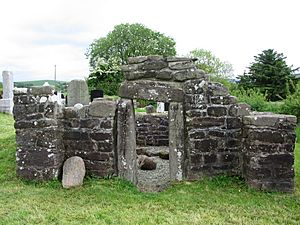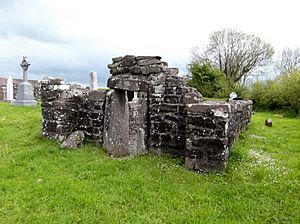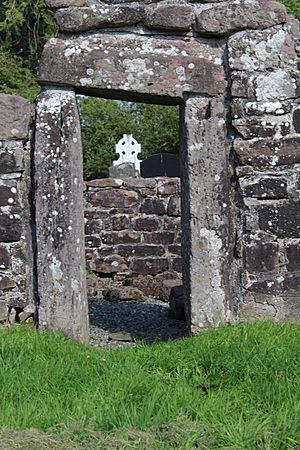Labbamolaga Church facts for kids
Quick facts for kids Labbamolaga Church |
|
|---|---|
|
Leaba Molaga
|
|
 |
|
| 52°18′39″N 8°20′52″W / 52.310764°N 8.347678°W | |
| Location | Labbamolaga Middle, Mitchelstown, County Cork |
| Country | Ireland |
| Denomination | Pre-Reformation Catholic |
| History | |
| Dedication | St. Molaga |
| Relics held | St. Molaga |
| Architecture | |
| Functional status | ruined |
| Style | Celtic Christian |
| Closed | by 16th century |
| Specifications | |
| Length | 11.8 m (39 ft) |
| Width | 7.2 m (24 ft) |
| Number of floors | 1 |
| Floor area | 85 m2 (910 sq ft) |
| Materials | stone, mortar |
| Administration | |
| Diocese | Cloyne |
Labbamolaga Church is an ancient church building in County Cork, Ireland. It is now a ruin, but it is also a special place called a National Monument. This means it is protected because of its history.
Contents
Where is Labbamolaga Church?
Labbamolaga Church is found about 7.3 kilometers (4.5 miles) northwest of Mitchelstown. It sits on the east side of the Monaheancree Stream.
A Look at Its History
Ancient Stones and Legends
Right next to the church, you can see four very old standing stones. These stones were put there during the Bronze Age, thousands of years ago. They might have been part of a stone circle.
There's a fun local story about these stones! People used to say they were four thieves. The story goes that these thieves stole a special cup (a chalice) and other important items from the church. As punishment, they were turned into stone!
Saint Molaga and Beekeeping
In the 7th century AD, a holy person named Saint Molaga started a church and a monastery here. He is also the person who gave his name to another place called Timoleague. Saint Molaga is famous for something else too: people believe he was the first to bring beekeeping to Ireland!
The Oratory and Its Special Stone
Around the year 900 AD, a small chapel, called an oratory, was built here. It was made to be a special tomb for Saint Molaga. Inside, there is a limestone slab with carvings. This stone is known as Leaba Molaige, which means "Molaga's Bed."
An old book called the Book of Lismore mentions this place as Eidhnen Molaige. This means "Molaige's ivy-covered church." For a long time, local people believed that touching Saint Molaga's tombstone could help cure rheumatism, a type of joint pain.
The church eventually became a ruin by the 16th century.
What the Church Looks Like
The Main Church Building
The main church building is a large, rectangular structure. It was built in the Romanesque style, which was popular in Europe a long time ago.
The Oratory's Design
The oratory is also rectangular, measuring about 6.33 meters (20.8 feet) long and 4.45 meters (14.6 feet) wide. Its western doorway is made from three very large stones. Some people think these stones might have come from the ancient megaliths nearby. This could show how Christianity took the place of older beliefs.
The Cross Slab
In the old graveyard, there is a special stone called a cross slab. On one side, it has a Celtic cross carved into it. On the other side, you can see a Latin cross.
Cursing-stones
Underneath a stone slab, there are several round hollows called bullauns. These were known as clocha mealachta, which means "stones of rebuke."
See also




